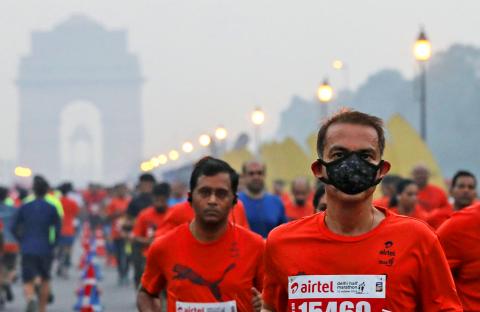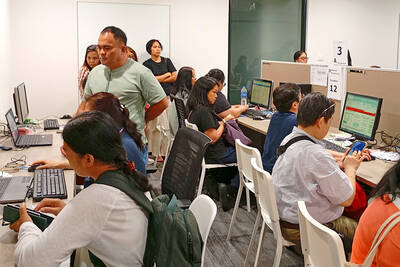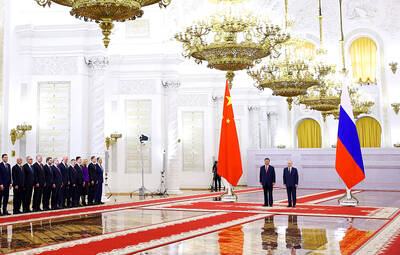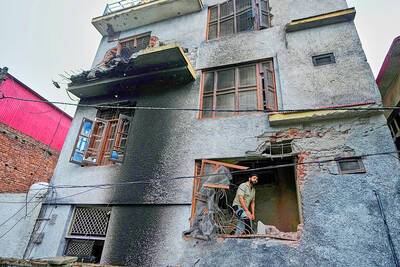New Delhi’s half-marathon race yesterday used ultra-high frequency (UHF) radio waves to clear the air for the runners, an experimental technique the organizers hope could improve the city’s notorious air quality.
India is home to the world’s 14 most-polluted cities. Last year, the smoke from burning crop waste and thousands of firecrackers contributed to a toxic smog that blanketed the capital, New Delhi, and a large part of northern India.
New Delhi Chief Minister Arvind Kejriwal said the city would face the same fate this year if Indian Prime Minister Narendra Modi’s ruling Bharatiya Janata Party did not do more to combat pollution.

Photo: Reuters
After medical experts urged the canceling of last year’s race, marathon organizers responded by bringing the race date forward to October, away from November’s Diwali festival when the firecrackers are set off.
They also tried to dampen down the dust that hangs over the city in winter, including reagents from the mining industry to treat roads, dropping water vapor along the course from a height of 6m.
The techniques also included using the UHF waves to dispel pollution from particulate matter measuring 2.5 micrometers or smaller, known as PM2.5, whose small size allows it to lodge deep in the lungs, damaging the respiratory system.
“It was a great day with clear skies and no pollution-related incidents among our 35,000 runners,” Vivek Singh, a managing director of race promoter Procam International, told reporters.
He said the Delhi government, which last year resorted to shutting power stations and banning some cars from roads to clear the air, should look at using the UHF technology, manufactured by Bengaluru-based company Devic Earth, to mitigate pollution.
“We have shown that it works and made a point to tell the authorities,” he added.
Amateur runner Pranav Patil said the air appeared clearer than last year, when competitors complained of burning eyes and sore throats.
“Today was better. My friends and I were happy, we ran hard and enjoyed the run,” the 26-year-old said.
“I did doubt signing up, but it was just the usual morning haze, and didn’t feel hard to run in,” said Emily Jackson, a British carbon market analyst living in New Delhi who competed in the race for the first time. “I only saw one person with a mask.”
Others were more cautious.
“Pollution is always there in Delhi. I think everybody should wear a mask,” said Neeraj Chhibba, who jogged along in a mask.
Singh said the measures had reduced pollution by at least 30 percent during the race, although readings from air quality at monitoring stations near the route were still rated as “very unhealthy” under international standards.
The US embassy Web site showed that levels of the smallest and most harmful airborne pollutants reached 199 at race time — eight times the WHO’s safe maximum.
The women’s race was won by Ethiopian Tsehay Gemechu in a course-record time of 1:06:50, while teenage compatriot Andamalak Belihu finished first in the men’s race with a time of 59:18.

A new online voting system aimed at boosting turnout among the Philippines’ millions of overseas workers ahead of Monday’s mid-term elections has been marked by confusion and fears of disenfranchisement. Thousands of overseas Filipino workers have already cast their ballots in the race dominated by a bitter feud between President Ferdinand Marcos Jr and his impeached vice president, Sara Duterte. While official turnout figures are not yet publicly available, data from the Philippine Commission on Elections (COMELEC) showed that at least 134,000 of the 1.22 million registered overseas voters have signed up for the new online system, which opened on April 13. However,

ALLIES: Calling Putin his ‘old friend,’ Xi said Beijing stood alongside Russia ‘in the face of the international counter-current of unilateralism and hegemonic bullying’ Chinese President Xi Jinping (習近平) yesterday was in Moscow for a state visit ahead of the Kremlin’s grand Victory Day celebrations, as Ukraine accused Russia’s army of launching air strikes just hours into a supposed truce. More than 20 foreign leaders were in Russia to attend a vast military parade today marking 80 years since the defeat of Nazi Germany in World War II, taking place three years into Russia’s offensive in Ukraine. Putin ordered troops into Ukraine in February 2022 and has marshaled the memory of Soviet victory against Nazi Germany to justify his campaign and rally society behind the offensive,

ENTERTAINMENT: Rio officials have a history of organizing massive concerts on Copacabana Beach, with Madonna’s show drawing about 1.6 million fans last year Lady Gaga on Saturday night gave a free concert in front of 2 million fans who poured onto Copacabana Beach in Rio de Janeiro for the biggest show of her career. “Tonight, we’re making history... Thank you for making history with me,” Lady Gaga told a screaming crowd. The Mother Monster, as she is known, started the show at about 10:10pm local time with her 2011 song Bloody Mary. Cries of joy rose from the tightly packed fans who sang and danced shoulder-to-shoulder on the vast stretch of sand. Concert organizers said 2.1 million people attended the show. Lady Gaga

CONFLICTING REPORTS: Beijing said it was ‘not familiar with the matter’ when asked if Chinese jets were used in the conflict, after Pakistan’s foreign minister said they were The Pakistan Army yesterday said it shot down 25 Indian drones, a day after the worst violence between the nuclear-armed rivals in two decades. Pakistani Prime Minister Shehbaz Sharif vowed to retaliate after India launched deadly missile strikes on Wednesday morning, escalating days of gunfire along their border. At least 45 deaths were reported from both sides following Wednesday’s violence, including children. Pakistan’s military said in a statement yesterday that it had “so far shot down 25 Israeli-made Harop drones” at multiple location across the country. “Last night, India showed another act of aggression by sending drones to multiple locations,” Pakistan military spokesman Ahmed